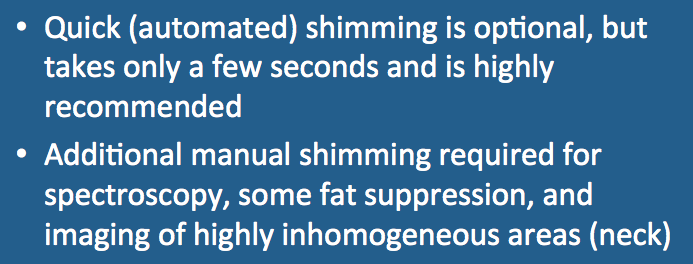As described in a prior Q&A, shimming is the process by which the main magnetic field is made more homogeneous by passing small calibrated electrical currents through the imaging gradients and higher order shim coils. Although an optional part of prescan, the "quick shim" method only takes a few seconds and is well worth leaving on. Several brands of scanners have automated shim procedures specifically designed for the area of study (brain, ankle, cardiac, neck, breast, etc). On other brands a shim volume must be specified as well as the intensity/complexity of shimming desired.
Additional shimming is highly recommended for whenever there is a change of gradient mode, change in table position, or change in anatomic region studied. It is especially useful over irregularly shaped areas (like the neck, wrist, ankle, and foot) or areas where there are steep changes in susceptibility (skull base, chest). Shimming is also highly recommended whenever spectral fat suppression, echo-planar imaging, phase-sensitive sequences (like TrueFISP/FIESTA), or functional imaging is used. Very detailed high-order shimming is mandatory for spectroscopy. Although spectroscopy shimming can be automated, the settings always require review and often tweaking by the MR technologist.
Additional shimming is highly recommended for whenever there is a change of gradient mode, change in table position, or change in anatomic region studied. It is especially useful over irregularly shaped areas (like the neck, wrist, ankle, and foot) or areas where there are steep changes in susceptibility (skull base, chest). Shimming is also highly recommended whenever spectral fat suppression, echo-planar imaging, phase-sensitive sequences (like TrueFISP/FIESTA), or functional imaging is used. Very detailed high-order shimming is mandatory for spectroscopy. Although spectroscopy shimming can be automated, the settings always require review and often tweaking by the MR technologist.
Advanced Discussion (show/hide)»
No supplementary material yet. Check back soon!
References
Gruetter R. Automatic, localised in vivo adjustment of all first- and second-order shim coils. Magn Reson Med 1993; 29:804-811. (This paper is the origin of the " FASTMAP" technique, widely used for rapid automated shimming based on measuring Bo field plots along projections.)
Gruetter R. Automatic, localised in vivo adjustment of all first- and second-order shim coils. Magn Reson Med 1993; 29:804-811. (This paper is the origin of the " FASTMAP" technique, widely used for rapid automated shimming based on measuring Bo field plots along projections.)
Related Questions
What is the scanner doing during the automatic pre-scan period?
What is the scanner doing during the automatic pre-scan period?
